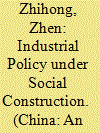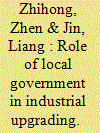| Srl | Item |
| 1 |
ID:
144038


|
|
|
|
|
| Summary/Abstract |
The merger and acquisition (M&A) of Carlyle and Xuzhou Construction Machinery Group (XCMG) is an important takeover case between a foreign corporation and a leading Chinese enterprise in recent years that deserves the special attention of researchers interested in the Chinese political economy. This case involves multiple actors and a complicated institution environment. For the agreement to be reached, this M&A case required the approval of Xuzhou municipality, Jiangsu province and the central government of China. Regulatory authorities such as the State-owned Assets Supervision and Administration Commission of the State Council (SASAC), National Development and Reform Commission (NDRC) and Department of Foreign Investment Administration and Ministry of Commerce of China were also actively involved in the process. Moreover, the M&A activity of Carlyle–XCMG took place in the context of an important shift in China’s development strategy from “market in exchange for technology” to “independent innovation”. In accommodating the shift, the state administration adjusted its development-oriented ideologies towards “independent innovation”, which had had an impact on the M&A case of Carlyle and XCMG.
|
|
|
|
|
|
|
|
|
|
|
|
|
|
|
|
| 2 |
ID:
144035


|
|
|
|
|
| Summary/Abstract |
China’s high-speed railway (HSR) has experienced rapid development in the past five years. The author explains that institutional factors, namely national monopoly on market resources, a highly centralised management system and substantial support from various departments in the State Council, have contributed to the sector’s growth. Adhering to the independent innovation strategy and by means of “mobilising resources to accomplish large undertakings”, the state created an industrial development model known as the “government-oriented integrated innovation model”, which capitalises on the institutional advantages as mentioned above. Through this model, with the entire national railway network being operated under a unified command and dispatch system, China was able to acquire core technologies from the market, integrate a complex array of subsystems and develop a portfolio of production and research, all of which were conditions essential for achieving the rapid development of high-speed railway in China. This article, in analysing the institutional origins of China’s development of the high-speed railway, sheds light on China’s unique institutional advantages in shaping its national competitive advantages in the world economy today.
|
|
|
|
|
|
|
|
|
|
|
|
|
|
|
|
| 3 |
ID:
144042


|
|
|
|
|
| Summary/Abstract |
This article examines China’s largest textile industrial cluster in Shaoxing county as a case study of how developing countries could carry out industrial upgrading in the face of globalisation’s challenges. The authors argue that the local government could play a crucial role in transforming comparative advantages of the local economy into competitive advantages using various policy tools. The Shaoxing county government rewarded and subsidised local textile enterprises to carry out independent innovation and research and development (R&D), facilitated foreign investments and technology transfer, guided local enterprises to build up their own brands, introduced preferential policies to encourage local enterprises to participate in international competition and motivated local enterprises to expand export. This demonstrates that the county government’s guiding hand and policy measures are instrumental in leading textile enterprises to reshape their competitive advantage, integrate into the global market and upgrade the industry.
|
|
|
|
|
|
|
|
|
|
|
|
|
|
|
|